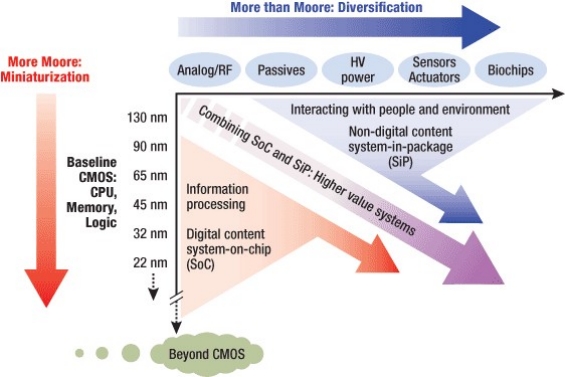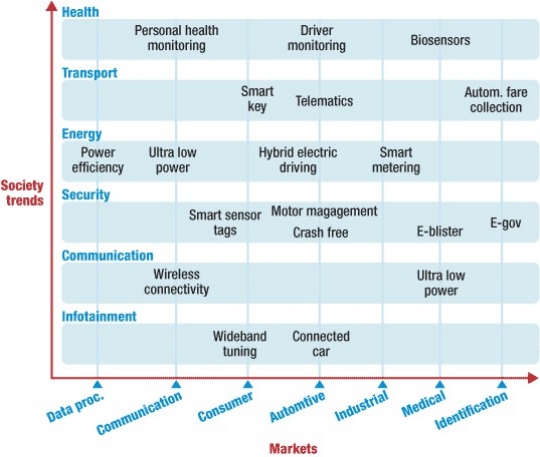by Laura Peters, contributing editor
January 10, 2011 – The 2010 Update to the International Technology Roadmap for Semiconductors (ITRS) was released in late December. While the major ITRS revisions are released in odd years (the next one is due in December 2011), the 2010 Update contains many important indicators of where the technology is going — including serious consideration as to whether a formal roadmap should be constructed according to the More-than-Moore trend, i.e. adding functionalities not associated with transistor scaling to increase device value (Figure 1).
 |
| Figure 1: The combined need for digital and non-digital functionalities in an integrated system is translated as a dual trend in the ITRS: miniaturization of the digital functions ("More Moore") and functional diversification ("More-than-Moore"). |
Such a roadmap would be incorporated into the ITRS, helping researchers to better focus efforts, allowing the global community to benefit from pre-competitive cooperation and further fueling semiconductor industry growth:
- Guide the research effort worldwide
- Synchronize the technology development and the timely availability of manufacturing tools and methods
- Increase the resource efficiency through focus
- Promote market growth and job creation
A recent white paper summarizes the first-pass considerations of a More-than-Moore roadmap. The paper notes that the two technologies work together, with More Moore constituting the digital processing center of systems and More-than-More enabling interaction with the outside world. As such, More-than-Moore devices transducer physical signals (electromagnetic, mechanic, chemical, or biologic parameters) to electrical signals.
The ITRS defines the preconditions for world-wide technology roadmapping as:
- Progress of the underlying technology is defined by a figure of merit (FOM), whose value continuously increases or decreases
- A majority of key industry players agree on the FOM (the law of expected progress)
- Sufficient potential market exists to warrant pre-competitive effort (wide applicability of technology)
- Willingness to share technology development and roadmapping
- Existence of a community of players and a value chain
To determine which More-than-Moore building blocks would be amenable to roadmapping, the ITRS committee suggests evaluating whether the above criteria are met, then identify the technologies and devices already covered by the ITRS (such as RF) and other roadmaps, and then identify the tools and processes specifically used to fabricate those devices.
More-than-Moore applies to many different societal needs across health and wellness, transport and mobility, security and safety, energy and environment, and communication and e-society (including infotainment). These societal needs can be linked to markets (Figure 2) and the devices serving those markets. To see if these devices lend themselves to roadmapping efforts, the same analysis is performed to see if the figure of merit, agreement on expected process, etc., can be met. For instance, one More-than-Moore area that is already part of the roadmap is the chapter on radio frequency (RF) and analog-mixed signal technologies for wireless communications. Next, the markets, devices and functions are analyzed to see where common functions exist to serve different devices and markets. Where sufficient markets exist and a clear figure of merit can be identified and tracked, the roadmap can be put into place.
 |
| Figure 2: Example of an application matrix linking societal needs and market segments. |
Finally, the ITRS committee recognizes existing roadmaps and does not plan to duplicate efforts. The white paper highlights three examples in optoelectronics: MELARI published a roadmap in the late 1990s, the European Technology Platform PHOTONICS21 published a Strategic Research Agenda in 2006, and the European project MONA published a roadmap looking specifically on the impact of nanotechnologies in optics in 2009.

